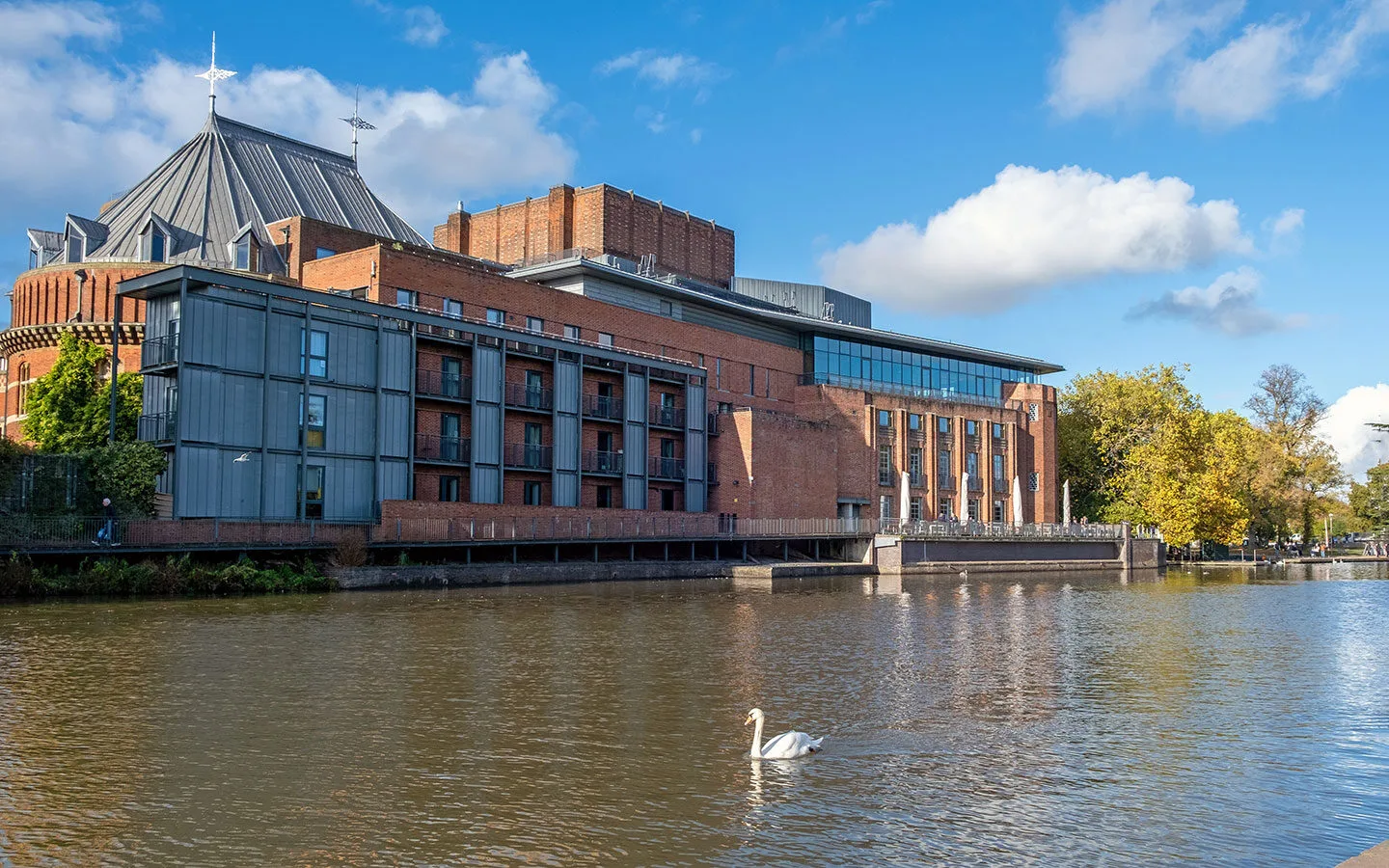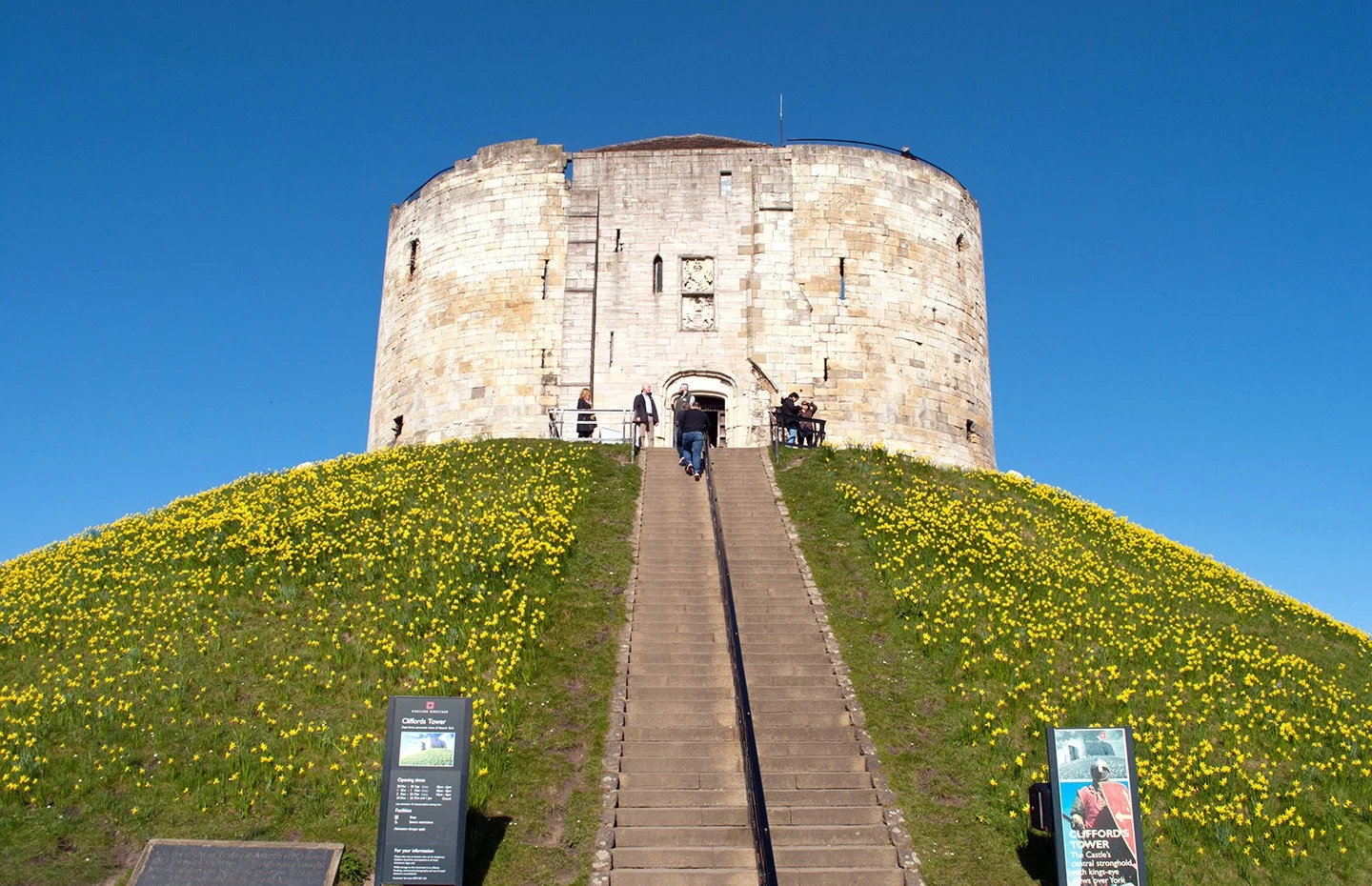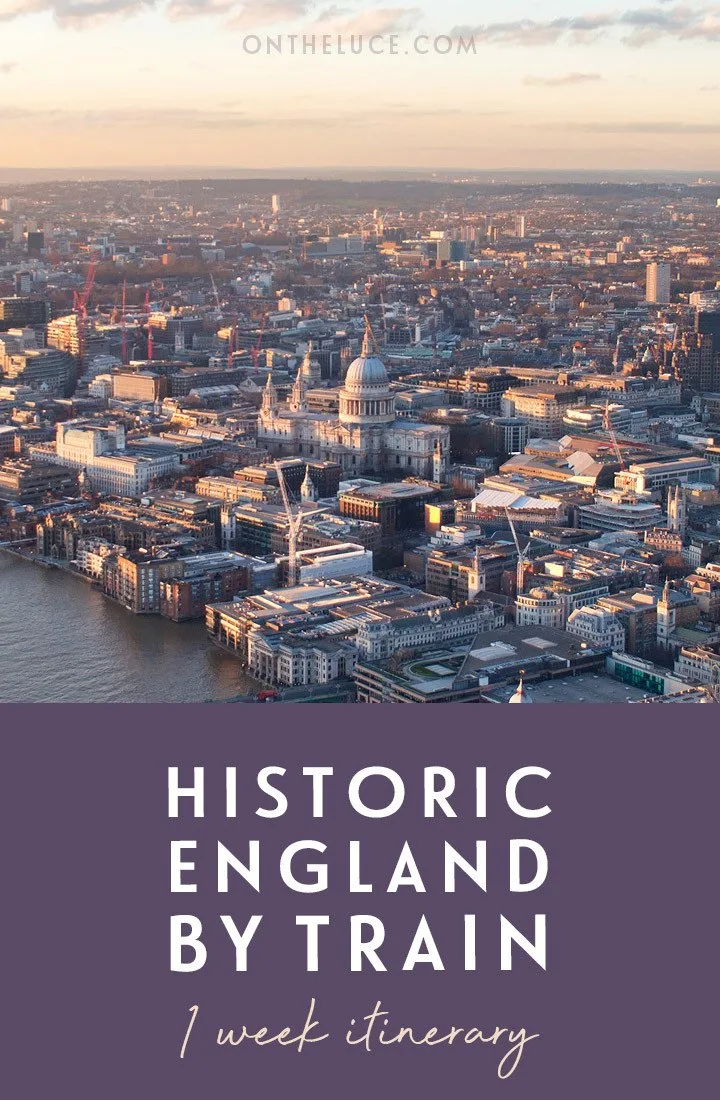Explore the historic cities of England by train in just one week as you visit castles, cathedrals and colleges on this rail itinerary from London to Salisbury, Bath, Oxford, Stratford-upon-Avon and York.
* This site contains affiliate links, where I get a small commission from purchases at no extra cost to you.

From the Vikings to the Victorians, the Romans to the Reformation, travel across the country and back through time on this journey through England by train. You’ll follow in the footsteps of statesmen, writers and royalty as you travel from London to Salisbury, Bath Spa, Oxford and Stratford-upon-Avon and York, all without needing a car.
Experience some the country’s best cathedrals, colleges, museums and monuments on this one-week Historic England by train itinerary, which will show you which trains to take, how much they cost, how to book and what to see, do and where to stay along the way.
One-week Historic England by train itinerary

Day 1: London
Start your England by train trip with a full day in the UK capital. London has over 2000 years of history to discover, so choose a few of its historic highlights. Follow in the footsteps of kings and queens at Westminster Abbey, meet the Beefeaters and ravens at the Tower of London*, get an insight into royal life at Windsor Castle, admire Sir Christopher Wren’s handiwork at St Paul’s Cathedral or climb to the top of the Monument.
London is packed with museums and galleries – and most are free to visit. Learn about the city’s history at the Museum of London, see artefacts from across the world at the British Museum, go interactive at the Science Museum or admire the National Gallery’s artworks.
Or you can check out some of London’s unusual attractions, like the Old Operating Theatre surgical museum or underground tours of the city’s abandoned Tube stations.

London’s also a great place for theatre – catch a show in the West End or see one of Shakepeare’s plays at the Globe. And if the sun’s shining (it does happen…) head to one of London’s parks and gardens to soak it up, with boating on the Serpentine lake in Hyde Park, Japanese gardens in Regent’s Park and skyline views from Primrose Hill.
Where to stay in London: The CitizenM Tower of London* hotel’s location above Tower Hill Tube station makes it easy to get around, with views of the tower and Thames. There’s only one category of compact room, with high-tech extras like a tablet to control lights and blinds. There’s also a colourful lounge, café and rooftop bar with panoramic views.
Read more: Visiting London on a budget

Day 2: London > Salisbury
Next morning, leave London behind and take a 1.5-hour train journey west to Salisbury. The 09.20 service from London Waterloo arrives in Salisbury at 10.45. Then spend the rest of the day exploring the city. Salisbury is compact and easy to get around on foot, located where four rivers meet the River Avon and surrounded by tranquil water meadows.
Salisbury’s most famous site is its Gothic-style 13th-century cathedral, with the tallest spire in the UK. Join a tower tour and climb up 332 steps for a close look at the spire and views out across the city. Or wander around the cathedral’s atmospheric cloisters and visit the Chapter House, home to one of only four surviving copies of the Magna Carta.
Take a stroll around pretty Cathedral Close with its neatly manicured lawns and grand Elizabethan and Georgian mansions. You can find out more about the area’s history at the Salisbury Museum or visit the Rifles Berkshire and Wiltshire military museum.

There’s also Arundells, the former home of British Prime Minister Ed Heath, and the 18th-century Mompesson House with its antique furniture and glassware.
Or travel two miles north of Salisbury and 2000 years back in time to Old Sarum. It was originally an Iron Age fort and was later occupied by the Romans and Saxons. William the Conqueror built a castle here and it was the site of the first Salisbury cathedral until it was replaced by the current one in 1220 – though all that’s left now are its foundations.
Where to stay in Salisbury: The half-timbered Best Western Red Lion Hotel* was built in the 13th century, making it England’s oldest purpose-built hotel. It’s full of character, with rooms featuring medieval fireplaces, antique furniture and four-poster beds.
Read more: A weekend in Salisbury: 2-day Salisbury itinerary

Day 3: Salisbury > Bath Spa
Carry on travelling west on the one-hour train journey to Bath Spa – the 09.42 train from Salisbury arrives into Bath at 10.38. Bath was originally known as Aquae Sulis when it was founded by the Romans in 60 AD, brought here by its natural thermal springs.
You can tour the Roman Baths and Temple of Sulis Minerva – though if you want to take a dip you’re better off at the modern Thermae Bath Spa with its spectacular rooftop pool.
Bath is also known for its links with Jane Austen, who lived in the city from 1801–1806. Learn more about her life at the Jane Austen Centre, join in the annual Jane Austen festival each September, try traditional Georgian dress at the Fashion Museum or enjoy tea at the Pump Rooms, which features in her novels Northanger Abbey and Persuasion.

Channel your inner Austen heroine with a walk around the curving Royal Crescent, lined with elegant Georgian townhouses – and see how people lived then at Number 1 Royal Crescent, which has been turned into a museum. Visit Bath Abbey and try a Sally Lunn bun, a type of brioche spread with butter or cream that dates back to the 17th century.
Where to stay in Bath: Splash out on a night at Bath’s most desirable address at the Royal Crescent Hotel*. Two townhouses have been merged to create a luxurious five-star hotel, with period artworks and antiques, a hidden garden, restaurant, bar and spa.
Read more: A weekend in Bath: 2-day Bath itinerary

Day 4: Bath > Oxford
The following day, travel from Bath to Oxford, just over an hour away. Catch the 09.43 train from Bath Spa, changing in Didcot Parkway and arriving in Oxford at 10.50. Oxford is one of the world’s oldest and most famous university cities, with a string of notable alumni which includes 30 British Prime Ministers and over 60 Nobel Prize-winners.
Take a walking tour* led by a former University of Oxford student to find out more about its history and bizarre traditions. The university’s 38 colleges are dotted around the city and many are open for visitors to wander around their quads and honey-stone buildings.
Christ Church College is the star attraction – not least for being a Harry Potter filming location as well as the home of Oxford’s cathedral – but other colleges which are well worth a visit include Magdalen, New College, Trinity, St Johns and All Souls.

Discover arts and antiquities from across the globe at the Ashmolean Museum – and enjoy one of the best views over the city from its rooftop restaurant. Or spot quirky curios like voodoo dolls and a witch in a bottle at the Pitt Rivers Museum.
And you can’t visit Oxford without giving punting a try. Hire a punt beneath Magdalen Bridge (along with a ‘chauffeur’ if you’d rather someone else did the hard work) and head out through the Botanic Gardens and Christ Church College Meadows.
Where to stay in Oxford: Spend the night behind bars at the Malmaison Oxford*, the city’s former Victorian prison. The cells have been converted into boutique hotel rooms and the visitors’ room into a cocktail bar, but it’s kept the original stairs and walkways.
Read more: A weekend in Oxford: 2-day Oxford itinerary

Day 5: Oxford > Stratford-upon-Avon
After a leisurely breakfast, catch the 10.40 train from Oxford for the 1.5-hour train journey to Stratford-upon-Avon, changing trains en route at Leamington Spa (arrive at 11.16 and depart on the 11.39 service which arrives into Stratford-upon-Avon at 12.13).
This medieval market town was founded in 1196 and is best known as the birthplace of the Bard – William Shakespeare. There’s a wide selection of Shakespeare sites around the town which you can visit, including the Shakespeare’s Birthplace museum in the house where he was born and grew up, and the Schoolroom and Guildhall where he was taught.
There’s also Anne Hathaway’s Cottage where his wife grew up, New Place where he spent his married life, and Holy Trinity Church where he was baptised and buried.

Make sure to catch a performance of one of Shakespeare’s plays at the renowned Royal Shakespeare Company (RSC) theatre. Once you’re all Shakespeared out, take a walk or boat ride along the River Avon, call in for a pint at the 16th-century Garrick Inn or try some of the interactive games at the MAD (Mechanical Art and Design) Museum.
Where to stay in Stratford-upon-Avon: The Hotel Indigo* is opposite Shakespeare’s New Place and a couple of minutes from the RSC. Its Tudor building mixes historic features and a bright, light-filled extension, with a courtyard garden and cosy library snug.
Read more: A weekend in Stratford-upon-Avon: 2-day itinerary

Day 6: Stratford-upon-Avon > York
The following day, finish your Historic England by train trip by travelling north to York. The journey takes around 4 hours, departing Stratford-upon-Avon at 10.08 and arriving into Birmingham Moor Street at 10.56, where you transfer to Birmingham New Street (a 10-minute walk away) for the 12.03 service which arrives in York at 14.30.
Then you have the rest of the day and the next morning to explore York. Take your pick from the different eras of history which have left their mark. Walk the two-mile Roman walls circling the city or go back to the time of the Vikings at the Jorvik Viking Centre.
Climb up to Clifford’s Tower on the site of William the Conqueror’s original castle or admire the stained glass windows and climb the tower at York Minster.

The 14th-century half-timbered buildings of the Shambles are one of York’s prettiest spots – and the starting point for nightly ghost tours. Indulge your sweet tooth at the Chocolate Story* or with afternoon tea at Betty’s. And don’t miss the Castle Museum, my favourite spot in York is a former prison turned eclectic museum with recreated Victorian Street.
Where to stay in York: Just outside the centre in a leafy residential area, Clementine’s Town House* is a former gentleman’s residence, with antique furniture, roll-top baths and four-poster beds, along with a restaurant rated one of the top places to eat in York.
Read more: A weekend in York: 2-day York itinerary

Day 7: York
Spend your last morning seeing more of York. You can stick with the train theme and visit the National Railway Museum, which has 100 trains on display – from a Japanese Shinkansen bullet train to Queen Victoria’s Royal Train. Or take a 45-minute guided boat trip along the River Ouse for a relaxing way to finish off your weekend.
Then if you’re flying back home, the nearest airport to York is Leeds Bradford. To get there you can catch the train to Leeds and the 757 bus to the airport, taking 1 hour 40 minutes altogether. Or if you’re heading back to London its 2 hours by direct train.

More time?
If you have more time, you could travel an hour north to Durham, another historic university city with a UNESCO World Heritage-listed cathedral and castle. Or carry on across the border to Scotland and spend a few days in Edinburgh (2.5 hours).
Visit Edinburgh Castle and Greyfriars Kirk, listen to bagpipers on the Royal Mile, explore the underground streets of Mary King’s Close or climb Calton Hill at sunset. And from Edinburgh you could also add on the one-week Scenic Scotland by train trip, which visits Glasgow, the Highlands and Isle of Skye, to make it a two-week UK rail trip.

How much does it cost?
When you’re planning a UK rail trip, you can either book individual tickets or get a railpass, which can be a better deal if you’re under 28/over 60, want more flexibility or are booking late. Here’s how the prices break down for the two different options on this route.
Individual tickets
Ticket prices depend on how early you book and if you’re booking a specific train or want to be flexible. There are three main fare categories: Advance, Off-Peak or Anytime. Advance are cheapest and can be booked 8–12 weeks in advance, but are non-transferable so you’re tied to a specific train. Off-Peak services are valid on any train outside weekday peak hours. And Anytime are the most expensive but can be bought on the day and used on any train.

Using the cheapest Advance fares, the cost of trains on this route starts at £141 per person:
- London > Salisbury: from £18.20
- Salisbury > Bath Spa: from £8.00
- Bath Spa > Oxford: from £24.20
- Oxford > Stratford-upon-Avon: from £22.60
- Stratford-upon-Avon > York: from £68.40
You can also save a third on all rail fares with a Railcard*. These cost £30 with different versions for 16–25s, 25–30s, Seniors and Disabled People. You can also get a Two Together railcard for two named adults travelling together, or a Friends and Family Railcard for up to four adults and four children. Both UK and overseas residents are eligible.

The railpass option
There are various rail passes available, and which you’re eligible for depends on where you live. If you live outside the UK, you can can get a InterRail/Eurail pass (InterRail is for European residents and Eurail is for non-European residents) or BritRail pass. They work in a similar way and cover either a set time period or a certain number of travel days.
For this England by train itinerary, the best InterRail/Eurail option is the One Country Great Britain pass for 5 travel days within 1 month (£220 adults, £191 youths aged 12–27 or £198 seniors over 60). Or the best BritRail option is the England Pass for 8 Consecutive Days (£224 adults, £179 youths aged 16–25 or £190 seniors over 60).

Passholders are recommended to make seat reservations – though it’s probably only worth doing for long-distance services or at busy peak times so you’re guaranteed to get a seat – which you can do for free at any UK train station up to two hours before departure.
Rover tickets are also available, which give you unlimited train travel either all across the UK or in a certain region, and are available to both UK and overseas residents. For this itinerary you would need an All-Line Rover for 7 Days, but at £571 adults/£285 children it’s pretty pricey so you’re likely to be better off booking individual tickets.

How to book
There are a variety of websites where you can book UK train journeys, but some charge a booking fee. To avoid fees you can book with Transport for Wales* and either use a mobile ticket on your phone or collect them from a ticket machine or a counter at the station. Or if you have an international credit card you can book with The Trainline for a small fee.
Don’t want to do it yourself? You can also book a custom trip based on this Historic England by train itinerary through our partners Byway,* the flight-free holiday platform, which includes transport and accommodation.
Save for later






Viji
Saturday 2nd of April 2022
I loved your 1 week ' historic England" itinerary, just what I was looking for in my upcoming UK trip. As I can understand it from your mentioned itinerary, the train travel ends in York, from where you have mentioned to take the flight back to London. Wish to know, can you take the train journey from York to London so that it makes a round trip? Kindly revert so I can plan my journey accordingly. In fact I have 9 days to cover England and not 1 week. So any locations to add from York to London, will appreciate it! Many thanks!!
Lucy Dodsworth
Saturday 2nd of April 2022
Hi, yes it's easy to catch the train back to London from York and only takes 2.5 hours. If you've got some extra time and looking for another historic city to add you could also visit Cambridge which is just over an hour north of London.
Meaghan
Saturday 13th of June 2020
I've done York (and loved it) but Oxford, Stratford and Bath are still on my list! I'd definitely recommend Chester, too.
Lucy Dodsworth
Wednesday 17th of June 2020
I loved Chester too – couldn't quite fit it into this itinerary but it is in my Wales and Borders rail trip – it's definitely one of the underrated UK cities.